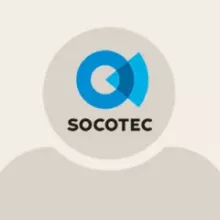Foundation problems can have major consequences for the stability and value of a property. SOCOTEC Netherlands offers the Quickscan Foundation Risk, a quick and cost-effective method to detect potential foundation problems without the need for a full foundation survey. This innovative method was developed in cooperation with the Kennis Centrum Aanpak Funderingsproproblematiek (KCAF) and offers reliable results based on standardized measuring methods.
What is a foundation risk and why is it important?
Foundation risks refer to issues that arise when a building's foundation no longer meets the requirements needed to safely support the structure. This can lead to settlement, cracks in walls or floors, or even structural instability. Foundation problems are especially severe in areas with soft soil, such as peat or clay, which are common in the Netherlands.
Timely identification of foundation risks is crucial to prevent serious damage and ensure the safety of buildings. Early detection of foundation problems saves long-term costs, prevents property damage, and can help protect a building's value. This is especially important for housing corporations, municipalities, property managers, and other real estate professionals responsible for maintaining and ensuring the safety of multiple properties.

Talk to our experts
How does the SOCOTEC Quickscan work?
The Quickscan Foundation Risk is a fast, efficient, and cost-effective way to detect foundation problems without the need for a full foundation survey. The Quickscan consists of three non-invasive measurement methods performed on the exterior of the building:
1. Visual Inspection: Assessment of cracks in the facade and other visible signs of foundation problems.
2. Plumb Line Measurement: Measurement of the vertical alignment of the facade to check for tilting or settlement.
3. Joint Mortar Measurement: Measurement of the horizontal alignment of the facade to check for deformations that may indicate foundation issues.
How does the SOCOTEC Quickscan work?
The Quickscan Foundation Risk is a fast, efficient, and cost-effective way to detect foundation problems without the need for a full foundation survey. The Quickscan consists of three non-invasive measurement methods performed on the exterior of the building:
1. Visual Inspection: Assessment of cracks in the facade and other visible signs of foundation problems.
2. Plumb Line Measurement: Measurement of the vertical alignment of the facade to check for tilting or settlement.
3. Joint Mortar Measurement: Measurement of the horizontal alignment of the facade to check for deformations that may indicate foundation issues.
Investigation of foundation issues
Research carried out in 2012 by engineering firm Deltares estimated that 400,000 homes on wooden piles in the Netherlands could face foundation problems. In addition, there are another 150,000 homes with foundations on steel that may have to be repaired. The cause is not only the ageing foundations. Climate impact such as drying out is also affecting the piles, the drought last summer being the latest example. The research results have been in for some time now, but an integrated approach to the problem was still lacking. And that whilst around 555,000 homes in the Netherlands might not be future proof. Housing associations, such Woonstad Rotterdam, and private owners bear the brunt of these problems. In the past 3 years this has led to around 1000 complaints from around 70 municipalities being lodged with the KCAF.
The foundations are investigated on the basis of these complaints. The result of this (condition) assessment is that the houses are declared safe (‘code green’) or that action is required in the short term (‘code red’). Between the two, ‘code orange’ has an enforcement period of 5 to 20 years. Since it is difficult to predict the lifespan and the investment required for the repairs (sometimes as much as 50,000-100,000 euros per home, an enormous burden for the housing associations), an integrated approach is needed for the “Code Orange” homes.

Unique collaboration between the government, knowledge institutions and companies has determined a strategy to monitor these homes using sensors. KCAF, the housing associations, owners and SOCOTEC are collaborating to install the sensors. However, the involvement of many different players who all want to see and use the data in real time means that a new way had to be found to offer access to the data. That is why it was necessary to join forces with Oudeman.io and Packhunt.io for the hardware and software respectively. Together, the infrastructure has been set up that is required to send the data from the field to the cloud and then communicate it to the parties involved via an interactive portal. The portal not only shows the data, but also warns if problems are expected. To make it possible for decisions to be taken with regard to the data collected such as ‘When should intervention occur?’, a research council has been established in cooperation with TU Delft that will examine the data and issue advice with regard to the homes monitored.
This makes it possible to assess the condition of the structures and trends and also issue a warning if intervention is required. Investment decisions are thus clearer, the lifespan is extended and occupants are relieved of their worries. Each construction (both homes and infrastructure) can be fitted with sensors so that these “Code Orange” structures can become futureproof again.
Want to know more about our Services ?






